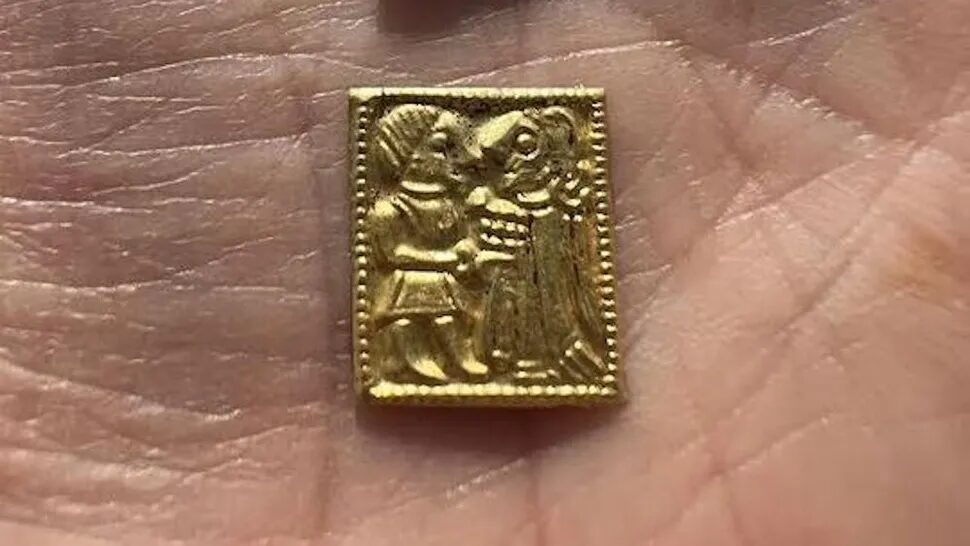

Archaeologists have discovered 35 miniature gold-foil depictions of Norse gods tucked inside the remnants of a pagan temple in Norway.
The gold foils, which are flat and as thin as a piece of paper, contain etched motifs depicting the god Frøy and the goddess Gerd and date to the Merovingian period in Norway, which began in 550 and continued into the Viking Age, according to Science Norway. The foils may have been used as sacrificial offerings.
The gold pieces lack holes, so it's unlikely that they were worn as jewelry. The first gold foils were discovered in Scandinavia in 1725 and were eventually labeled as "gullglubber," which translates to "golden old men."
"This is a very special find," Kathrine Stene, the archaeologist who led the excavation this summer, told Live Science. "Each foil is quite small and measures about the size of a fingernail."
Several of the roughly three dozen gold foils were packed inside postholes that once contained support beams for the building in Hov, a village in southern Norway, while others were found where the structure's walls once stood.

Although similar foils have been found in Norway and across Scandinavia — including in similar pagan buildings in Bornholm, Denmark, and Uppåkra, Sweden — this is the first time that archaeologists have discovered the foils in a smaller structure.
"But more of these small pieces of gold keep appearing," Ingunn Marit Røstad, an archaeologist at the Museum of Cultural History in Oslo, told Science Norway. "Either through excavation or with metal detectors. So, more could pop up in various places in Norway as well."
During a separate excavation, archaeologists discovered 30 similar foils elsewhere in Hov.

By looking at the postholes, researchers could measure the structure's footprint and determined that it was roughly 49 feet (15 meters) in length. In comparison, most homes during that time period were between 66 and 98 feet (20 to 30 m) long.
There's been some speculation about how the foils got there. While some researchers have suggested the gold pieces were used as an admission fee to enter the building, Stene said it's more likely that the foils were placed there during construction.
"Based on where we found them where the walls once stood and inside the postholes, they couldn't have been used as tickets to enter into the building," Stene said. "It's more likely that they were used as more of a sacrifice so that this special building would have a good life.
"We're happy that we found them," she added. "This was considered a sacred place to pagans."
Jennifer Nalewicki is a Salt Lake City-based journalist whose work has been featured in The New York Times, Smithsonian Magazine, Scientific American, Popular Mechanics and more. She covers several science topics from planet Earth to paleontology and archaeology to health and culture. Prior to freelancing, Jennifer held an Editor role at Time Inc. Jennifer has a bachelor's degree in Journalism from The University of Texas at Austin.



Reader Comments
But yes, christians killed and maimed, tortured to force the Norsemen into their religion - it's all OK because yahweh is a jealous god and the old testament is full of killing the "bad guys".
I find if you want truth - look to the east. But who knows what we lost from these regions?
Frankly what percentage of Earth's population gives a 💩 = 0%
There's much to discuss here but I'd rather SOTT bring it to the table then it's contributors.
No?
I'll translate...
"We haven't got a fucking clue what we're doing. We don't know what anything is. Here's a bunch of bullshit that roughly falls in line with what a previous bunch of clueless bullshitters have said that will keep the grants coming".
And welcome to another session of Rich Guy Viking Bingo!!!
FFS.
Need something to laugh about and archeology (especially former Saxon areas) offer the best insider jokes/narratives.
Stone Henge is the ultimate injoke in european archeology, its the druids you see....lol
Experts....that will always make me smile, ever since covid it just ticks all the boxes "expertise" hahaha